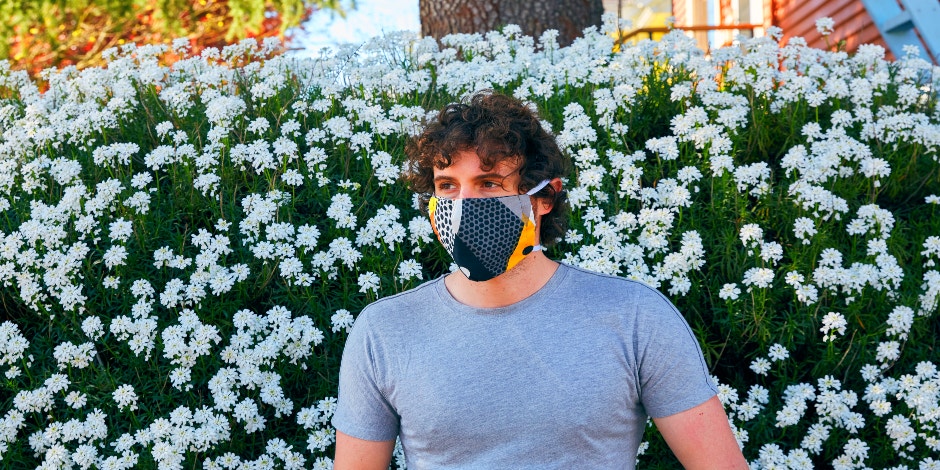A Step-By-Step Guide To Wearing, Sanitizing & Reusing Your Face Mask
Reuse your mask safely.
 getty
getty Face masks have been a source of debate since the earliest outbreak of the coronavirus. There has been much back and forth on who should wear them and whether they work, but expert opinions have widely shifted to being pro-mask.
Last month, the Centers for Disease Control walked back on their earlier advice by recommending that everyone should wear a face mask when leaving home due to the difficulty involved in maintaining social distance when in public.
“The virus can spread between people interacting in close proximity — for example, speaking, coughing, or sneezing — even if those people are not exhibiting symptoms,” the CDC explained on its website. “In light of this new evidence, CDC recommends wearing cloth face coverings in public settings where other social distancing measures are difficult to maintain (e.g., grocery stores and pharmacies), especially in areas of significant community-based transmission.”
Since then, we’ve all been scrambling to get our hands on cloth masks from online stores or making our own out of old clothes.
But can you reuse face masks? And, if so, are there steps for how to clean cloth face masks to wear again?
First, it's important to know how to properly wear a face mask. Throwing on any scrap of fabric isn’t enough, so we all need to take a crash course.
There's a serious shortage of disposable masks and N95 masks, both of which should be reserved for frontline workers who need them most. So, we need to know how to wash our cloth masks effectively so we can reuse them.
Masks are as much for your own protection as they are for the protection of others. We need to educate ourselves on how to correctly wear and sanitize our masks in order to ensure we beat this virus.
Here's how to clean and sanitize your face mask.
1. Wash your hands first, and be aware of how you touch the mask.
First things first, you must start off with clean hands. Good hygiene practices remain the most crucial measure you can take to prevent the spread of coronavirus, according to the World Health Organization.
Having squeaky clean hands will prevent you from contaminating your mask and yourself when putting it on. Be careful to avoid touching the inside of your mask when putting it on.
Handle your mask using only the elastic or ties. Touching the inside of your mask is the same as touching your face, and we all know how coronavirus experts feel about that!
2. Cover all breathing passages.
An ill-fitting mask isn’t much more protective than wearing no mask. It’s important to fully cover not just your mouth but your nose as well.
Ensure that the fabric is tight to the skin with no major air leaks. Keep your mask on at all times when outside your home.
"In general, a mask is less helpful or counterproductive if it is not covering the nose and mouth — such as worn down around the neck for extended periods of time or if it is poorly fitting to the point that it requires frequent adjustment, which brings your hands close to your face repeatedly," says Dr. George Anesi, director of the Medical Critical Care Bio-response team at Penn Medicine.
If there's air coming in from the bottom or top of your mask, tie it a little tighter. This simple act could make all the difference.
Make all these adjustments before leaving the house and then don’t touch the mask again until you can wash your hands before doing so.
3. Remove the face mask carefully.
Complacency while removing the mask is where a lot of people go wrong.
You’ve carried home all your shopping goods and want to breathe freely again, but all your protective efforts could be undone if you simply pull the mask off and leave in on your kitchen table!
Instead, untie your mask from the back of your head, being careful to never touch the front of the mask. Taking the mask off from the back ensures you’re pulling the fabric away from your face as you remove it, rather than sliding it over your head or leaving it hanging around your neck.
Fold the mask over itself so the contaminated outside part of the mask is no longer exposed.
4. Wash the mask immediately.
Disposable masks allow us to immediately throw away any potentially contaminated fabrics, but with cloth masks we don’t have that option... unless you want to DIY every item of unworn clothing you own!
So, it’s important that we don’t leave contaminated mask lying around. Toss your mask straight into your washing machine and leave it there until your next laundry load. If you don’t have a washing machine in your home and need to put the mask in your laundry basket, be careful to wash your hands after loading the machine.
Alternatively, place the mask on some paper towels or into a plastic bag until you can wash it.
5. Use hot water and soap.
Luckily, most detergents will kill germs that cause coronavirus, so there’s no need to purchase any special equipment.
“Soap and water kills the virus so you wash them like you regularly wash clothes. It’s a good idea to have a couple of masks so you have an opportunity to wash them,” advises Dr. Myiesha Taylor, an emergency medicine physician in South Lake, Texas.
Use the hot setting to ensure your masks are thoroughly cleaned. If you need a mask before your next laundry day, you could steep the mask in boiling water with some soap for a couple of minutes and then rinse it.
Be sure to regularly check for holes and tears in threads. The last thing you want is your mask breaking while you're out and about.
Alice Kelly is a writer with a passion for lifestyle, entertainment, and trending topics.

